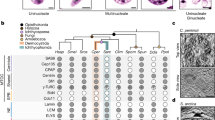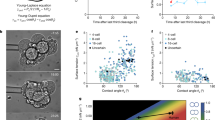Abstract
CYCLIC nucleotide phosphodiesterase inhibitors and exogenous cyclic AMP or cyclic GMP can increase or maintain mammalian sperm motility, respiration rate and fructolytic rate1–7. Sperm from various species have been shown to contain high activities of cyclic AMP-dependent protein kinase8–10, guanylate cyclase11,12, cyclic nucleotide phosphodiesterase11, phospho-protein phosphatase13, and adenylate cyclase11,14. These and other observations have led to speculation that cyclic nucleotides regulate or modulate sperm motility and metabolism15, and that this modulation may occur during the processes of capacitation or fertilisation15–17. The latter hypothesis requires that factors from the female or from the ovum itself alter sperm cyclic nucleotide levels. Until now there has been no demonstration of a naturally occurring factor of animal origin that can substantially change cyclic nucleotide levels in sperm15. The purpose of this study was to determine whether or not there are factors released from eggs that can alter sperm cyclic nucleotide levels. Gametes from sea urchins were used because both eggs and sperm can be obtained in large quantities, and because factors released from sea urchin eggs have been known for some years to alter sea urchin sperm motility18–20 and respiration20,21.
This is a preview of subscription content, access via your institution
Access options
Subscribe to this journal
Receive 51 print issues and online access
$199.00 per year
only $3.90 per issue
Buy this article
- Purchase on Springer Link
- Instant access to full article PDF
Prices may be subject to local taxes which are calculated during checkout
Similar content being viewed by others
References
Garbers, D. L., Lust, W. D., First, N. L., and Lardy, H. A., Biochemistry, 10, 1825–1831 (1971).
Garbers, D. L., First, N. L., Sullivan, J. J., and Lardy, H. A., Biol. Reprod., 5, 336–339 (1971).
Hoskins, D. D., J. biol. Chem., 248, 1135–1140 (1973).
Garbers, D. L., First, N. L., Gorman, S. K., and Lardy, H. A., Biol. Reprod., 8, 599–606 (1973).
Frenkel, G., Peterson, R. N., and Freund, M., Proc. Soc. exp. Biol. Med., 144, 420–425 (1973).
Morton, B., Harrigan-Lum, J., Albagli, L., and Jooss, T., Biochem. biophys. Res. Commun., 56, 372–379 (1974).
Garbers, D. L., First, N. L., and Lardy, H. A., Biol. Reprod., 8, 589–598 (1973).
Hoskins, D. D., Casillas, E. R., and Stephens, D. T., Biochem. biophys. Res. Commun., 48, 1331–1338 (1972).
Garbers, D. L., First, N. L., and Lardy, H. A., J. biol. Chem., 248, 875–879 (1973).
Lee, M. Y. W., and Iverson, R. M., Fedn Proc., 32, 643 (abstr.) (1973).
Gray, J. P., thesis, Vanderbilt Univ. Med. Sch. Lib., Nashville (1971).
Garbers, D. L., Hardman, J. G., and Rudolph, F. B., Biochemistry, 13, 4166–4171 (1974).
Tang, F. Y., and Hoskins, D. D., Biochem. biophys. Res. Commun., 62, 328–335 (1975).
Casillas, E .R., and Hoskins, D. D., Archs Biochem. Biophys., 147, 148–155 (1971).
Hoskins, D. D., and Casillas, E. R., in Advances in Sex Hormones Research (University Park Press, Baltimore, Maryland, 1974).
Morton, B., and Albagli, L., Biochem. biophys. Res. Commun., 50, 697–703 (1973).
Rogers, B. J., and Morton, B., Biol. Reprod., 9, 361–369 (1973).
Lillie, F. R., J. exp. Zool., 14, 515–574 (1913).
Lillie, F. R., Problems of Fertilization (University Chicago Press, Chicago, 1919).
Gray, J., J. exp. Biol., 5, 362–365 (1928).
Hathaway, R. R., Biol. Bull., 125, 486–498 (1963).
Garbers, D. L., Suddath, J. L., and Hardman, J. G., Biochim. biophys. Acta, 377, 174–185 (1975).
Schultz, G., Bohme, E., and Hardman, J. G., Methods in Enzymology, 38 (edit. by Hardman, J. G., and O'Malley, B. W.), 106–112 (Academic, New York, 1974).
Gilman, A. G., Proc. natn. Acad. Sci. U.S.A., 67, 305–312 (1970).
Brostrom, C. O., and Kon, C., Analyt. Biochem., 58, 459–468 (1974).
Schultz, G., Hardman, J. G., Schultz, K., Davis, J. W., and Sutherland, E. W., Proc. natn. Acad. Sci. U.S.A., 70, 1721–1725 (1973).
Steiner, A. L., Methods In Enzymology, 38 (edit. by Hardman, J. G., and O'Malley, B. W.), 96–105 (Academic, New York, 1974).
Author information
Authors and Affiliations
Rights and permissions
About this article
Cite this article
GARBERS, D., HARDMAN, J. Factors released from sea urchin eggs affect cyclic nucleotide metabolism in sperm. Nature 257, 677–678 (1975). https://doi.org/10.1038/257677a0
Received:
Accepted:
Issue Date:
DOI: https://doi.org/10.1038/257677a0
Comments
By submitting a comment you agree to abide by our Terms and Community Guidelines. If you find something abusive or that does not comply with our terms or guidelines please flag it as inappropriate.



